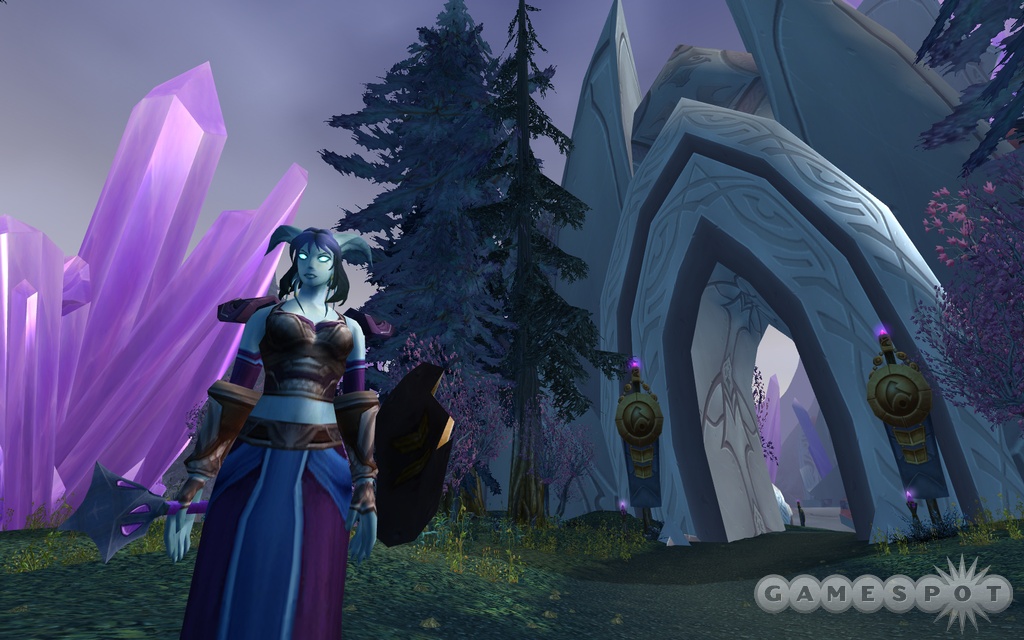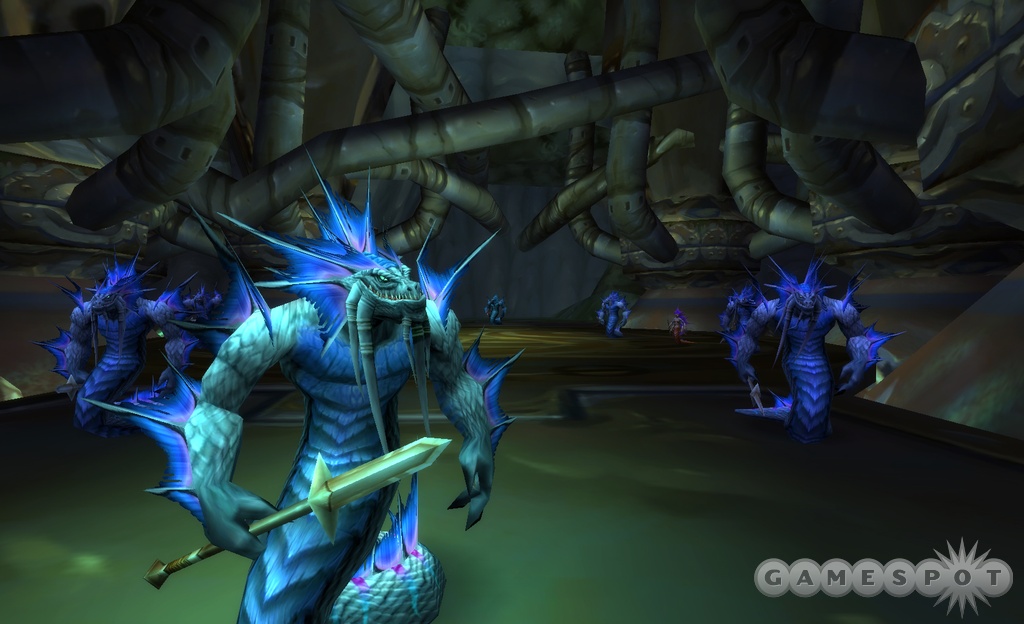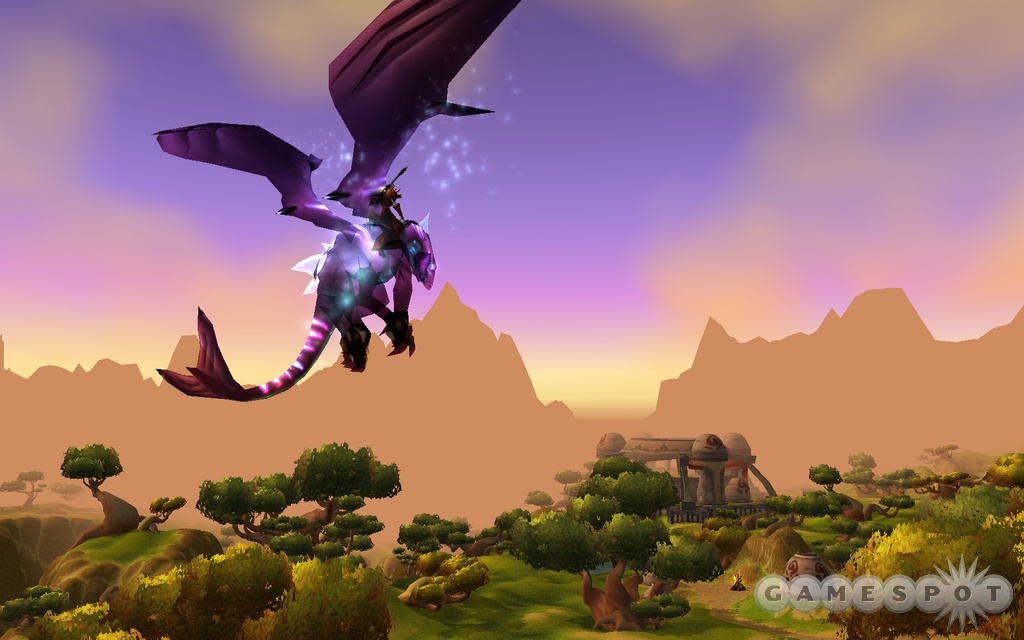World of Warcraft: The Burning Crusade Updated Impressions - PvP Details, Raid Details, and High-Level Zones
We take an updated look at the highly anticipated expansion pack for the popular massively multiplayer game.
It's no secret: Blizzard Entertainment's massively multiplayer game World of Warcraft is extremely popular all over the world. Millions of players log in to the online game daily (and nightly) to play as a character in the high-fantasy Warcraft universe, going on quests, gaining experience levels and loot from defeating powerful monsters, and even challenging each other in player-versus-player (PVP) battles between characters of the noble Alliance faction and the monstrous Horde faction. The big news for World of Warcraft fans is the upcoming Burning Crusade expansion pack, which will offer two brand-new playable races of characters (in addition to the game's orcs, trolls, elves, and dwarves), the addition of full access to the formerly unique shaman and paladin professions to both of the game's factions, an extended "level cap" that will let powerful characters who have attained experience level 60 to advance to level 70, flying rideable mounts, items that can be socketed with magical gemstones, and brand-new dungeons and outdoor areas for players of all experience levels. And as it turns out, that's not all--because Burning Crusade will also offer various enhancements to the game's high-end gameplay, such as dungeons that players raid in large groups, as well as PVP combat.

For starters, two major changes are being made to PVP: one, the game's existing "honor" system is being revamped so that it will no longer be a competitive ladder. Instead, players will be able to, according to lead game designer Tom Chilton, earn honor "at their own pace," and use their honor points as currency to spend on rewards. Secondly, Burning Crusade will add an all-new form of PVP: an arena combat system, which lets players form teams of two to five players and go up against other teams in designated arenas.
Interestingly, arena teams will function a lot like guilds (persistent groups of players that share chat channels and often go off on raids together), in that you'll have your own chat channels and you'll be able to swap players in and out of a team for different arena battles. Arena battles will even let players fight Horde versus Horde or Alliance versus Alliance battles, which should not only make for more-varied contests, but should also help keep arena battle queues moving along briskly, instead of having to match three queued-up Horde teams against 12 queued-up Alliance teams. Then again, the expansion's new races, particularly the Horde's blood elves (which look more aesthetically pleasing to a general audience than the original Horde races), might even things out so that the game's race balance will be less of an issue. Blizzard plans to have arena combat allow players to fight against each other across servers from the moment the expansion launches.
In addition, while Burning Crusade will definitely offer more challenging raid dungeon areas that are instanced (areas that are sealed off from the rest of the gameworld and exist only for the players who are playing in that instance), these dungeons will offer new tweaks as well. In response to player feedback, Burning Crusade's raid instances will be built for either 10- or 25-player raiding parties, rather than the standard 40-player raids. The change was made to help players put together tighter raiding groups with less waiting around for stray players--it's just easier and faster to coordinate when you've got nine other people, rather than 39.
In addition, Burning Crusade's raid dungeons will offer multiple difficulty settings based on your character's level, and may actually offer some replay value after you've finished them. For instance, the rampart section of the Hellfire Citadel dungeon, which lies beyond the Dark Portal (the same swirling gate flanked by two menacing statues that appears at the original game's login screen) will be well suited for players of level 60-62. However, once you've finished the dungeon in your early 60s and have climbed all the way to level 70, you'll be able to return to the area, set it to level 70 difficulty, and have a new experience in the same dungeon against tougher monsters who carry more-powerful loot. Currently, Blizzard plans to use the scaled-down raid-party size and the multiple difficulty settings only for Burning Crusade's dungeons, though the team is considering the possibility of adding these features to some of the dungeon areas in the original game at some point in the future.

We were fortunate enough to be able to take a guided tour of some of the game's new areas, including the home cities for each of the two new races, the Horde Blood Elves and the Alliance Draenei races will call home (as it turns out, each of these cities will have multiple auction house and bank locations to help alleviate overcrowding). And of course, each city will have vendors that buy and sell goods, including each race's mount animal--in the case of the Draenei, the "elekk" (a creature that bears more than a passing resemblance to a caparisoned war elephant), and in the case of the Blood Elves, the cockatrice. Like with all other standard mounts in the game, both the elekk and cockatrice will, as Chilton puts it, "look cool and go fast," though they won't possess any exceptional powers. However, some of the higher-level mounts, especially the flying ones like the nether drake, will be able to travel at exceptional speeds, as will the expansion's new epic flying mounts--an armored wyvern for the Horde and an armored griffon for the Alliance.
Epic Zones and Outland
Silvermoon Castle will be the home of the Blood Elves. The expansive city is built on stony white walls with gilded edges, and will actually be built around a gigantic temple bathed in a red, sorcerous light that radiates from the fingers of elf sorcerers, who must constantly focus on keeping a prisoner of the Naaru race (a line of insubstantial beings that consist almost entirely of light and energy) enslaved so that Blood Elves can force the divine essence of paladins into their own race. The Draenei, on the other hand, live in the serene city of Exodar, a settlement that's constantly tinted by soft lights from crystalline icons bearing the mystical signets of the Naaru--and perhaps this architecture isn't surprising, since the city is essentially a huge chunk of Tempest Keep, the home of the Naaru.

We also had a chance to take a brief tour of some of the expansion's other dungeon areas, as well as an overland area that will play host to the expansion's "open-world PvP." For starters, we visited the aforementioned Tempest Keep, a dungeon that Chilton described as "casual-friendly," since it, like some of the expansion's other dungeons, will be broken up into smaller subsections that can be tackled successfully by smaller pick-up groups. We passed through the dungeon's stony hallways adorned with more crystalline icons, occasionally passing a "boss" enemy. Chilton suggests that, in general, the expansion's dungeons will "have a boss fight about every 30 minutes or so, give or take," in order to keep the experience from seeming too slow. We then jumped ahead to the fabled Dark Portal, which looks a bit like how it's pictured in the World of Warcraft login screen, but bathed in red light from the Outlands (the otherworldly area to which the gate leads) and about five times bigger and taller.
After passing this towering entrance, we traveled along a rough dirt road cut through rocky hills infested with Fel orcs--the evil, bloodthirsty orcs possessed by demonic influence. These orcs will provide a good warm-up for the rampart area of Hellfire Citadel which lies at the end of the road, an area that, according to Chilton, "players can march right on into on launch day with a party of level-60 characters." Past the ramparts of Hellfire Citadel lie the fortress' military training area, where particularly angry and savage fell orc captains whip their recruits into shape. The military area is heavily, heavily populated with lots of fell orcs of different character classes, including powerful boss orcs surrounded by circles of warlocks, and eventually opens out on a courtyard where the area's boss, an extremely tough orc riding a flying mount, holds court. The fight against a flying enemy will likely prove tricky even for experienced players.
You can expect a similarly tough, but segmented challenge from Coilfang Reservoir--a subterranean pumping station operated by the sinister naga queen Lady Vasj (pronounced "Vosh"). That dungeon will be a gigantic cavern with huge pipes descending from the ceiling powered by titanic crystal capacitors. Like with the other dungeons we've discussed, Coilfang will be broken up into separate areas that can be tackled by players who may not be able to make the commitment to spend all night raiding. You'll also be able to further explore the lore of Warcraft with dungeons like the haunted Karazahn Tower, the original home of the sage Medivh (who predicts the disastrous turn of events in the early part of Blizzard's strategy game Warcraft III). The lower levels of the tower are a stables, where ghostly pages groom skeletal horses, though as your party ascends higher and higher, you'll find crazier and crazier sights, like a dilapidated opera house where an audience of ghostly aristocrats awaits the appearance of a random boss monster based loosely on a character from a famous play beneath a Michelangelo-esque fresco ceiling painting of cherubic orcs in clouds.
We then jumped to Nagrand, the sprawling, lush, green area we saw earlier at E3. Nagrand will be home not only to PVP arena, but also to a neutral town that will be a flashpoint for Burning Crusade's "open-world PVP." The town, which is built around a series of ravines spanned by ramshackle bridges, will begin as a neutral settlement at first, but can later be captured by either the Horde or Alliance faction. Once the town is captured, it will spawn some tough computer-controlled guards, but it will also let you fight your way into the outskirts, then eventually set up flight towers at the edges of these ravines that you can use to hop onto pre-set flying mounts, then go on bombing runs on the town, pelting the guards and any enemy players with damaging bombs as a first assault before charging in and capturing the settlement's control points, which act like the timed flags in shooters like Battlefield 2--stand near them long enough, and the control point will "convert" to your faction's control.

From the sound of it, Burning Crusade should have plenty to offer World of Warcraft fans, both for casual players who might want to restart the game as a Blood Elf or Draenei and play though about 20 levels of brand-new low-level content, and for advanced players who might want to skip ahead to the more-challenging dungeons and look into that whole flying mount thing. The expansion is scheduled for release before the end of the year. Stay tuned to GameSpot for further updates.
Got a news tip or want to contact us directly? Email news@gamespot.com
Join the conversation